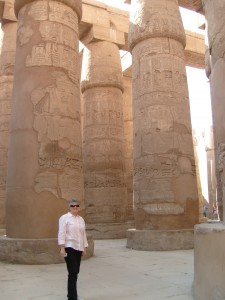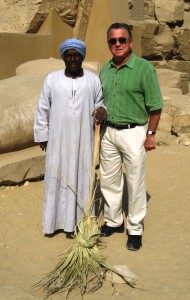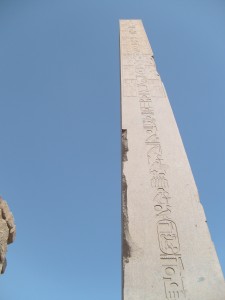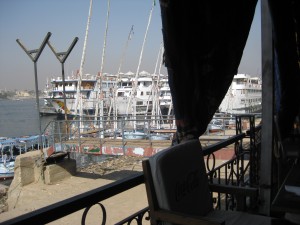Karnak, Luxor, and a quick day at the Temples
Wednesday, December 22, 2010
We are sort of tired of Cairo (just kidding), so it is time to fly somewhere else. How about Luxor? At 6 in the morning, the trip to the airport is about 20 minutes – basically following the yellow line down the middle of the road. After a 1-hour flight reminscent of San Diego to Vegas, we are picked up by our new host, Hussein, and driver, Muhammad. A quick stop at the 5-start Hilton to drop our bags (oh my this is a nice hotel!) and we are off to the Temple of Karnak.
 Luxor was the capital of Egypt for most of the Middle and Late Kingdoms, and is on the east bank of the Nile in central Egypt. Currently it has about one-half million residents and is considered a “town” compared to Cairo’s 11 million people. It is known for its “open-air” museum, the Temples of Karnak and Luxor.
Luxor was the capital of Egypt for most of the Middle and Late Kingdoms, and is on the east bank of the Nile in central Egypt. Currently it has about one-half million residents and is considered a “town” compared to Cairo’s 11 million people. It is known for its “open-air” museum, the Temples of Karnak and Luxor.  Luxor was built on the ancient site of Thebes, which existed from 2200 BC to 1800 BC. Though the Temple of Karnak emerged first in the 11th Dynasty (2100 BC), the main historical sites there were constructed during the 18th to 20 Dynasties in the New Kingdom Period, starting in about 1600 BC.
Luxor was built on the ancient site of Thebes, which existed from 2200 BC to 1800 BC. Though the Temple of Karnak emerged first in the 11th Dynasty (2100 BC), the main historical sites there were constructed during the 18th to 20 Dynasties in the New Kingdom Period, starting in about 1600 BC.
It is not good to keep saying something was amazing, but here we go again. When you walk into Karnak, it is hard to believe you are seeing what you are seeing. This is a football field-sized site, all of which is over 3000 years old. There are 134 massive columns arranged in 16 rows, 122 are 30 feet tall, and the other 12 are 60 feet tall with a diameter of over 9 feet. Many in very good condition, and have various drawing with hieroglyphics depicting Egyptian life.
I have neglected so far to mention anything about the folks in Egypt who dress in non-Western garb, and I don’t mean cowboy shoes. One memorable thing is that many of the men are dressed in galabayas, which are long cotton robes made of fabric like men’s shirts. Some older men, moreso in remote areas, wear turbans. You may see some pictures here and there of these guys. There was one worker at Karnak who allowed us to take his picture. He was especially dark skinned and was dressed this way. Note the broom.
It is here that I have to pause for a moment. This is where I mention how much I appreciate the fact that Dorothy said, “You cannot go to Egypt unless you read this book.” And she gave us a copy of “The Lost Technologies of Ancient Egypt.” In short, the books describes numerous things you see at the pyramids, Karnak and Luxor that are  very difficult to explain without mentioning large steel saws or aliens, and suggest techniques for creating the large stones and statues. I cite an example here, the Obelisk of Queen Hapshetsut at Karnak. You can see a picture of it here. It is 97 feet tall and weighs approximately 320 tons (some sources say 700 tons). An inscription at its base indicates that the work of just cutting the monolith out of the quarry required seven months of labor. Forgetting for a moment how the heck they got it upright, have a look at the picture and note how straight the edge is. I tried to take a picture that would should a little of the edge. I don’t want to go into it in detail, but man, it is really straight. The Lost Technologies book indicates that is is straight to a couple thousandths of an inch in its length. You have to see it to understand just how flat it is. How did workers in the 2nd millenium BC do that, carving with round stones of dolomite, copper tools, and sand?
very difficult to explain without mentioning large steel saws or aliens, and suggest techniques for creating the large stones and statues. I cite an example here, the Obelisk of Queen Hapshetsut at Karnak. You can see a picture of it here. It is 97 feet tall and weighs approximately 320 tons (some sources say 700 tons). An inscription at its base indicates that the work of just cutting the monolith out of the quarry required seven months of labor. Forgetting for a moment how the heck they got it upright, have a look at the picture and note how straight the edge is. I tried to take a picture that would should a little of the edge. I don’t want to go into it in detail, but man, it is really straight. The Lost Technologies book indicates that is is straight to a couple thousandths of an inch in its length. You have to see it to understand just how flat it is. How did workers in the 2nd millenium BC do that, carving with round stones of dolomite, copper tools, and sand?
Lunch was interesting. This was sort of a riverside Chevy’s, with beer and hamburgers, Arabic style. You can see the picture of our guide, Khassam, against the roof of colorful draperies, and the boats outside.

About 2 miles down the street is the Temple of Luxor, which was constructed starting in 1400 BC, later than Karnak,  in the New Kingdom Period. I show a couple pictures here, the most interesting of which is the old central road back to Karnak (and Carol), originally lined by sphinxs. It is being reconstructed (as are many of the antiquities) so that in a few years there will be a very nice walkway of 2.5 km between the temples.
in the New Kingdom Period. I show a couple pictures here, the most interesting of which is the old central road back to Karnak (and Carol), originally lined by sphinxs. It is being reconstructed (as are many of the antiquities) so that in a few years there will be a very nice walkway of 2.5 km between the temples.
If you ever get a chance to stay at the Hilton in Luxor, stay there. It has got to be a 5-star hotel. Rooms are contemporary but elegant, extremely comfortable beds. Service was extroardinary in all ways, but as in some exotic countries, they have difficulty sometimes in the bar getting your order right. Ok, the Christmas music in the lobby was funky, but nice try. At the Silk Road Restaurant we had a fantastic light eclectic oriental fusion dinner including seafood soup, vegetable tempura salad and lamb chops. The night view of the west bank and the Valley of the Kings was extroardinary (more on the west bank tomorrow).
Ahhhh, what a day! Let us go to bed.

The International Boottled Water Association (IBWA) has reported a record consumption of
bottled water recently Leaving out suchh websites is essential; however, one should know sites that sell genuine and quality pharmacy products bbuy drugs
no prescription [Valencia] If the line at the Pharmacy is
an indication, 90% of us are a pretty sickly lot Bodily therapists and physical remedy
assistants typically operate with patients to aid restore purpose,
boost mobility, prevent and limit disabilities and reduce discomfort On average it takes 12 months to
finish the mergers and acquisitions process buy drugs no prescription thus usually do not wait,
kick the dangerous habit of smoking by obtaining Chantix